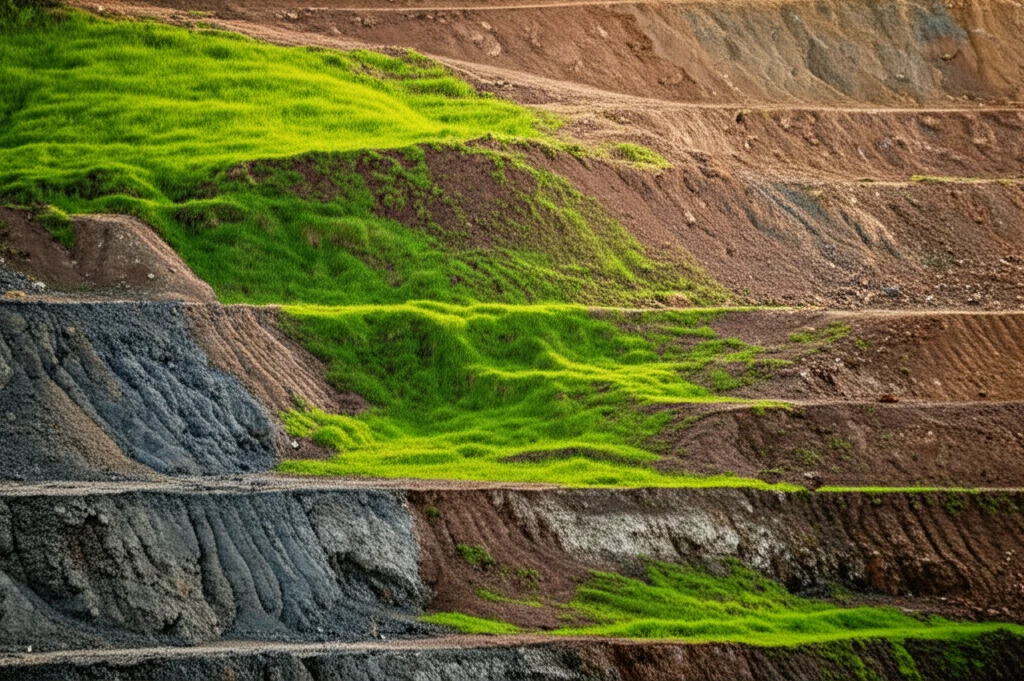
Turning Mine Waste into Green Pastures: How Innovative Soil Covers are Solving Acid Mine Drainage
"Discover how a unique blend of organic materials and limestone is revolutionizing acid mine drainage prevention, transforming toxic landscapes into thriving ecosystems."
For decades, the Curilo uranium deposit in Bulgaria was a hub of intensive industrial activity, focused on leaching uranium and producing uranium-bearing concentrates. However, this activity ceased twenty-five years ago, leaving behind a significant environmental challenge: acid mine drainage (AMD). AMD occurs when rainwater interacts with exposed minerals, creating acidic, metal-rich runoff that can devastate ecosystems and contaminate water sources.
The legacy of uranium mining at Curilo resulted in a landscape prone to spontaneous AMD generation, especially after rainfall. This process was primarily driven by indigenous acidophilic chemolithotrophic bacteria, which thrive in acidic conditions and accelerate the oxidation of pyrite, other sulfides, and uranium-bearing minerals. The result was a continuous outflow of polluted waters containing uranium, radioactive decay products, and various toxic heavy metals.
Efforts to combat AMD at the Curilo deposit have explored various methods, but one approach has shown particularly promising results: the construction of a specific soil cover rich in organic materials and crushed limestone. This method aims to neutralize acidity, inhibit bacterial activity, and ultimately prevent the generation of polluted waters. Let’s dive into how this innovative solution is transforming a former environmental liability into a potential ecological asset.
What Makes This Soil Cover So Effective?

The soil cover's success hinges on a carefully engineered composition and strategic construction. The process began by addressing the existing mining waste directly. The surface of a waste dump containing approximately 2600 tons of mining waste, characterized by particle sizes less than 25 mm, was treated. This dump had been constructed in 2003 using mining wastes that hadn't been directly exposed to air and rain, representing an initial effort to contain the problem.
- Initial Plugging: The top 0.5-meter layer of the dump was plugged to reduce water infiltration.
- Limestone and Organic Matter Addition: Crushed limestone was mixed with organic substrates like leaf compost, straw, and beef manure. This combination was incorporated into the ploughed ore to create a neutralizing and biologically active layer.
- Clay Soil Cover: A 0.5-meter layer of clay soil enriched with carbonates was placed over the mixture. This layer acted as a barrier to further reduce water infiltration and erosion.
- Vegetation: The soil layer was then grassed and planted with herbaceous plants typical of the region. This vegetation further stabilized the soil, promoted evapotranspiration, and added organic matter over time.
A Path to Sustainable Remediation
The construction of organic-rich layers, coupled with pH levels nearing neutral and a positive net neutralization potential, effectively altered the existing conditions within the dump. The resulting cover was characterized by a diverse microflora consisting of typical soil microorganisms. Sulphate-reducing bacteria and metabolically interdependent microorganisms became the primary inhabitants of the organic-rich, anaerobic lower part of the cover. Pollutant concentrations in the dump effluents significantly decreased, often falling below permissible levels for waters intended for agricultural or industrial use (with a few exceptions for iron, manganese, and sulfates in certain samples).
